Real eState
UK property register: What three luxury homes reveal about who owns UK real estate
|
|
The Register of Overseas Entities, launched in August 2022, was meant to reveal who ultimately owns UK property.
But analysis by BBC News and Transparency International found almost half of firms required to declare who is behind them failed to do so.
Labour MP Margaret Hodge said the legislation was not “fit for purpose”.


The UK government has long promised to crack down on “corrupt elites” from overseas, including “Russian oligarchs and kleptocrats”, using UK property to launder illegal wealth.
Ministers insisted they would crack down on foreign criminals using UK property to launder money by ensuring they “can’t hide behind secretive chains of shell companies”.
As a result, under a law passed in February 2022 in response to Russia’s invasion of Ukraine, ministers said anonymous foreign companies seeking to buy UK land or property would be required to reveal full details of the individuals who ultimately owned them. Overseas organisations that already owned land in the UK were given a six-month period to do the same.
Now that six-month grace period is up – all the people, whatever their reputations, behind companies that own thousands of British properties should have been uncovered for the first time.
The BBC and Transparency International matched thousands of filings from the new register with Land Registry records. This analysis suggests that some 18,000 offshore companies – which between them hold more than 50,000 properties in England and Wales – either ignored the law altogether or filed information in such a way that it remains impossible for the public to find out who the individuals are who ultimately own and benefit from them.
“While the register is starting to serve its intended purpose, our analysis reveals there are far too many companies that could be trying to skirt the rules, not knowing they exist, or ignoring them altogether,” says Duncan Hames, Director of Policy at Transparency International UK.
To understand how the law is and isn’t working, it helps to look at three very expensive properties. The first is a pair of luxury apartments. Another is a sprawling £48m estate in north London, the third a £10m country mansion.
All have been linked in some way to figures connected with Vladimir Putin’s regime.
For instance, look at the two luxury flats in central London worth an estimated £11m.


Their ownership by the former Russian deputy prime minister, Igor Shuvalov, was first reported by the Anti-Corruption Foundation, set up by jailed Russian opposition leader Alexei Navalny.
According to the UK government, who placed him under sanction in March 2022, Mr Shuvalov – who heads the management board of a Russian bank – is “a core part of Putin’s inner circle”.
And now the register has confirmed that he and his wife are the ultimate owners of the flats, held through a Russian company, Sova Real Estate LLC.
Mr Shuvalov’s spokesperson told the BBC last year that these issues “have been the subject of competent government audits”, and that “no complaints were ever filed”.
But while there are thousands of examples where the register is working, the ultimate ownership of thousands of properties remains shielded from public view.
Take Beechwood House, a north London estate bought for £48m in 2008 with a value around £85m.
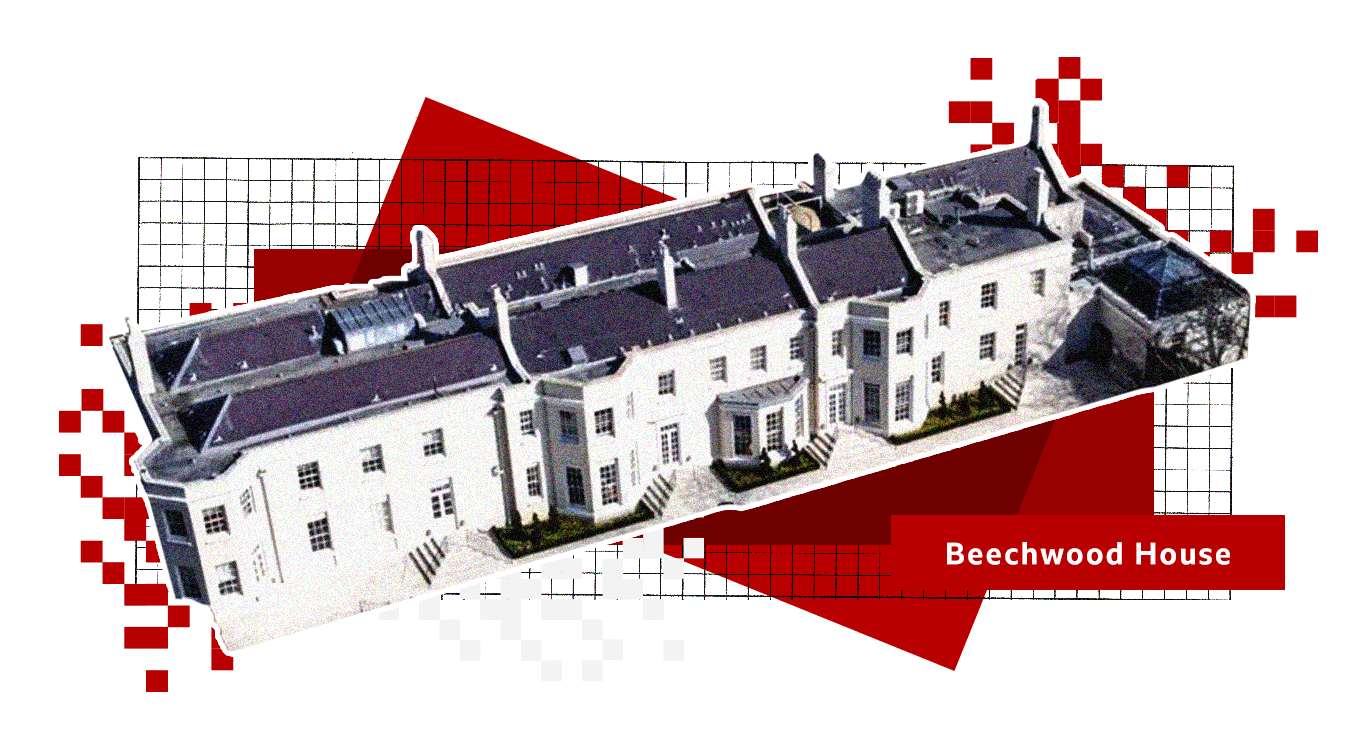

After Russia’s invasion of Ukraine 12 months ago, the UK government came down hard on wealthy businessmen close to Putin’s regime. Assets were frozen, stopping rich Russians from taking their money out of the UK.
But it wasn’t always clear exactly which assets belonged to these oligarchs.
For instance, Beechwood House was listed by the government as owned by oligarch and ex-Arsenal shareholder Alisher Usmanov when it announced sanctions against him.
A spokesperson for the oligarch has now told the BBC that he transferred Beechwood House, as well as other assets, to family trusts “long before sanctions were imposed” and that while Mr Usmanov was a beneficiary for a period of time, he withdrew “on an irrevocable basis”.
The spokesperson added: “Neither Mr Usmanov nor members of his family are the beneficial owners of these companies.”
You would think the register should shed light on who actually owns Beechwood House. But it does not.
The owner is given as Hanley Limited, an Isle of Man company. And in turn the beneficial owner of Hanley Limited is Swiss company Pomerol Capital SA, which controls it as part of a trust structure.
However, nothing about the individuals who own Pomerol Capital is listed on the public register.
That is because companies owned through trusts – as opposed to other set-ups – are exempt from having their beneficial owner information made public on the register.
So from the filing, it is impossible to identify the people who own, control or stand to benefit from Beechwood House- a property that the government itself said was owned by Mr Usmanov, which would have made it subject to an asset freeze.
While the names of individuals linked to trusts are not included in the register, companies do have to provide their details privately to the corporate registry Companies House.
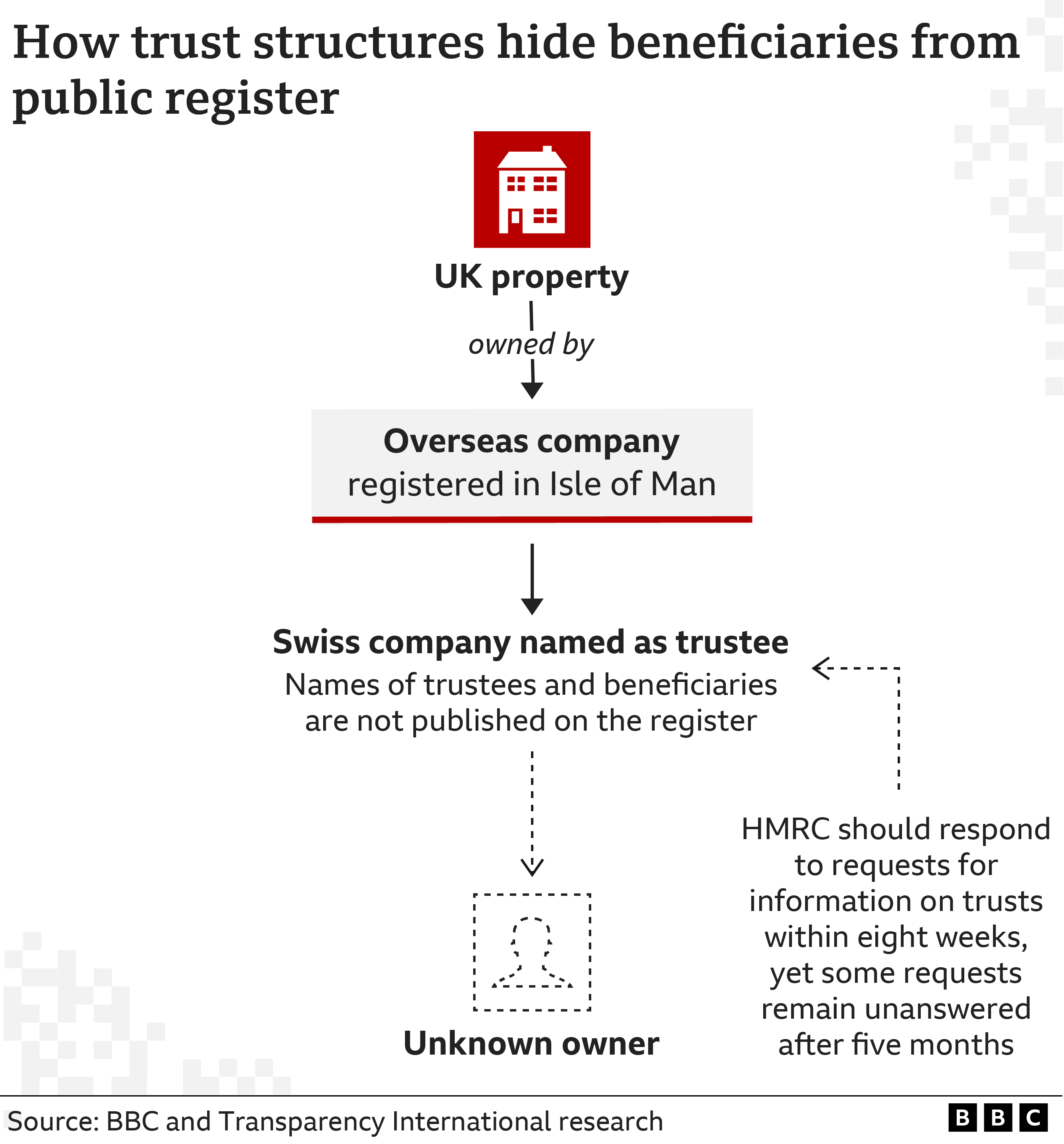

And many other owners have found an even more straightforward means of keeping their names off the register – by simply not complying with the new legislation.
Overseas companies with property in the UK – bought since January 1999 in England and Wales and since December 2014 in Scotland – were supposed to reveal the identity of their owners by 31 January.
But around half of offshore firms with property in England and Wales – approximately 15,000 – had no matching record in the property register before last week’s government deadline.
This includes the company that owns a £90m home in west London linked with former Chelsea owner Roman Abramovich. The Cyprus-based firm does not yet appear to have submitted its details to the property register.
Mr Abramovich could not be reached for comment.
As well as the firms that are yet to file, BBC analysis has found that one in four offshore companies that have submitted their details have actually included other foreign firms, not people, as their owners.


Some of these are owned by trusts, as with Beechwood House.
But that is not the only way in which companies are avoiding publicly disclosing the individuals who are actually behind them.
And there is a third category – companies that have filed their details to the property register, but have not complied with the rules.
The BBC’s investigation has identified more than 1,800 companies whose filings do not appear to do so.
Among these is Uart International, a Panamanian company that, according to Land Registry records, acquired a countryside mansion in 2008.


As part of the Pandora Papers, a leak of almost 12 million files, the property was owned through an offshore corporate network controlled by Vladimir Chernukhin and his wife, Lubov.
Mr Chernukhin is a former Russian deputy minister of finance and businessman who had financial links to oligarchs close to the Kremlin. He moved to the UK after being sacked by Putin in 2004 and insists he is not a supporter of the Russian president.
His wife Lubov, whom he married in London in 2007, is a major donor to the Conservative Party, having given the Tories more than £2.3m since 2012.
Companies House records show that Uart International lists another foreign firm as its “person of significant control”. This means that the individuals who ultimately own the property remain hidden from the public register, despite the change in the legislation.
Under the new regulations, another anonymous offshore firm should not be named as the owner of a company with UK property.
There is no indication in the filings that the company owner is a trustee, which would exempt the firm from having their person of significant control revealed on the register – suggesting it could be a violation of the rules.
Lawyers for the couple told the BBC that “Mr and Mrs Chernukhin do not support, and have never supported, the policies of President Putin, nor are they allies of President Putin” and that they are “unaware of Uart ever having made corporate filings contrary to the applicable rules and regulations in all relevant jurisdictions”.
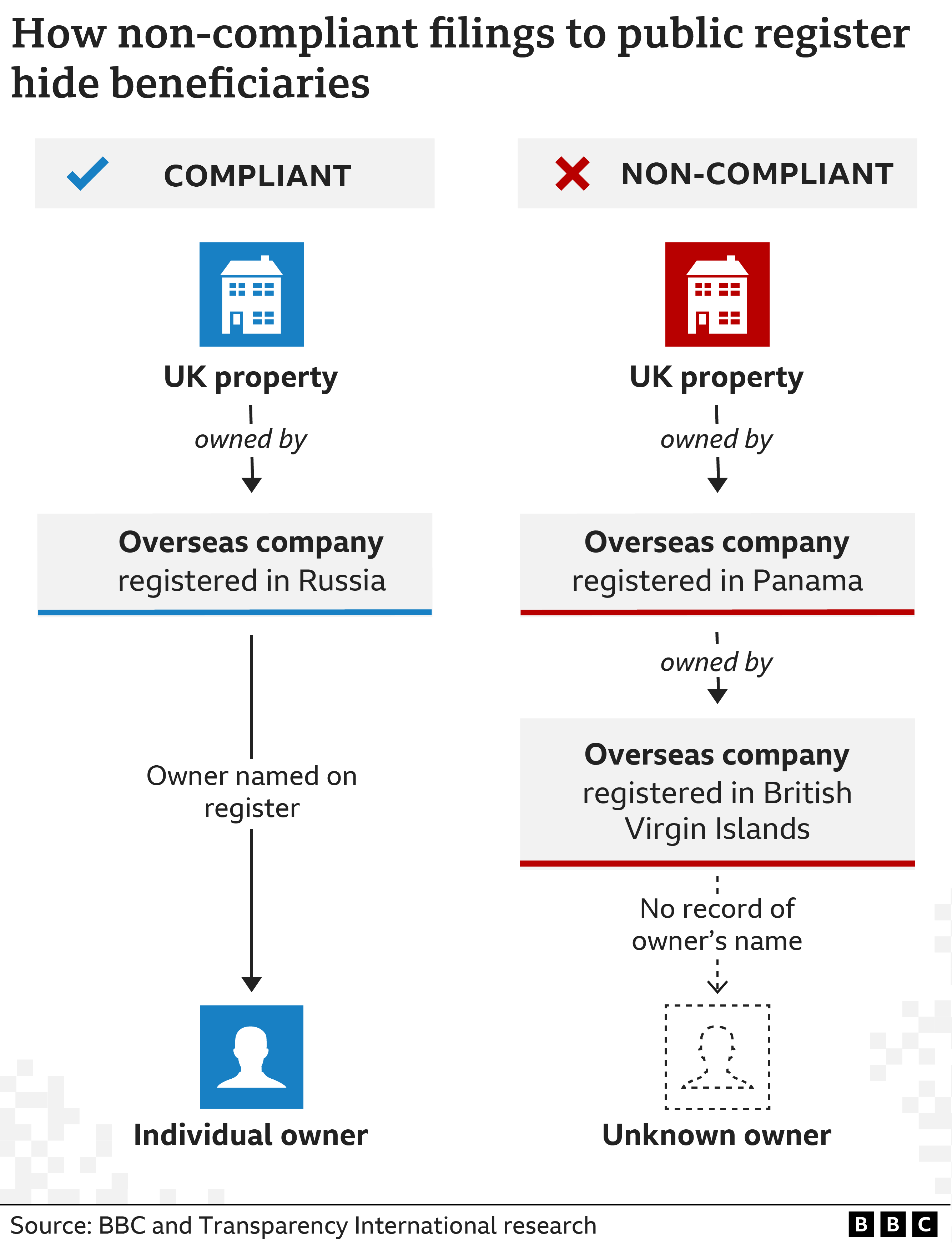

While the new rules include severe penalties for companies and individuals who do not comply, experts have questioned whether this will work.
“Although the legislation contains some stringent penalties for non-compliance, the government has failed to equip Companies House with the teeth and resources to apply these in practice,” says Helena Wood, head of the UK Economic Crime Programme at the Royal United Services Institute think tank.
Margaret Hodge MP, chair of the all-party parliamentary group on anti-corruption and responsible tax, said the new register was “turning into a joke”.
She added: “We need to know who owns these fantastically expensive properties, why they bought them and how they got the money to do so.”
A government spokesperson said that Companies House was now “assessing and preparing cases for enforcement action” and further legislation would allow it to impose fines and pursue legal avenues against companies that are flouting the law.
Additional reporting by Liana Bravo, graphics by Jana Tauschinski




Real eState
This Toronto home is a ’90s decor trip but a steal at only $600K
|
|
If you’re a millennial and grew up in the ’90s, you’ll probably remember a fair amount of ’90s home decor trends that might still haunt you to this day.
There were sponge-painted walls, all-beige everything, wallpaper borders, oak cabinets, carpets in places where there shouldn’t be carpets, bedroom sets from big-box stores, Southwestern or Tuscan decor in homes that weren’t in Arizona or Italy, and the list goes on.
We thought we’d left those troubling times in the past, but 39 Hatherley Rd. really brings back all those memories.
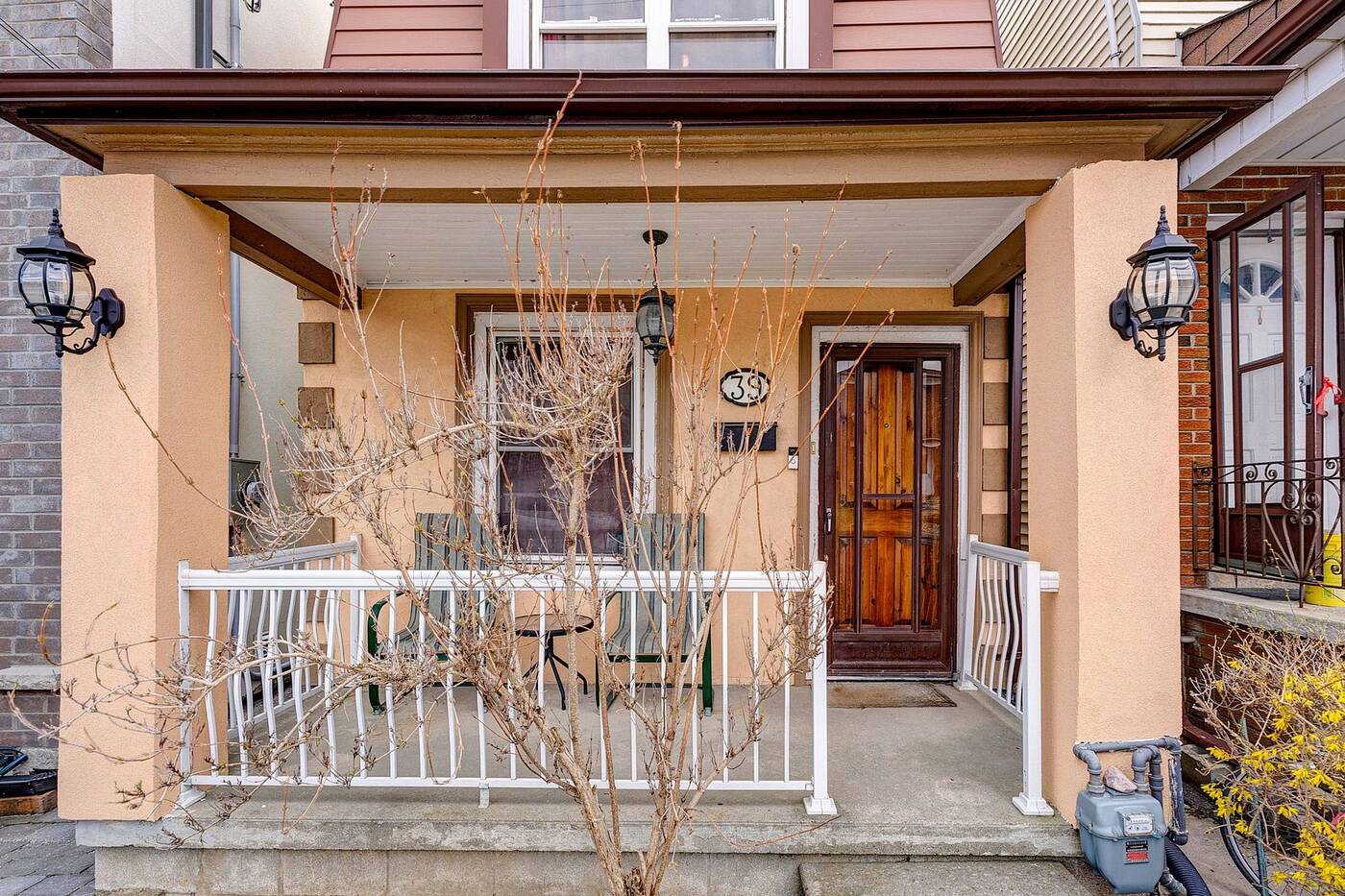

The front porch.
Somehow this two-bedroom, one-bathroom house hit almost every ’90s trend, except for carpets in the bathroom (phew!).
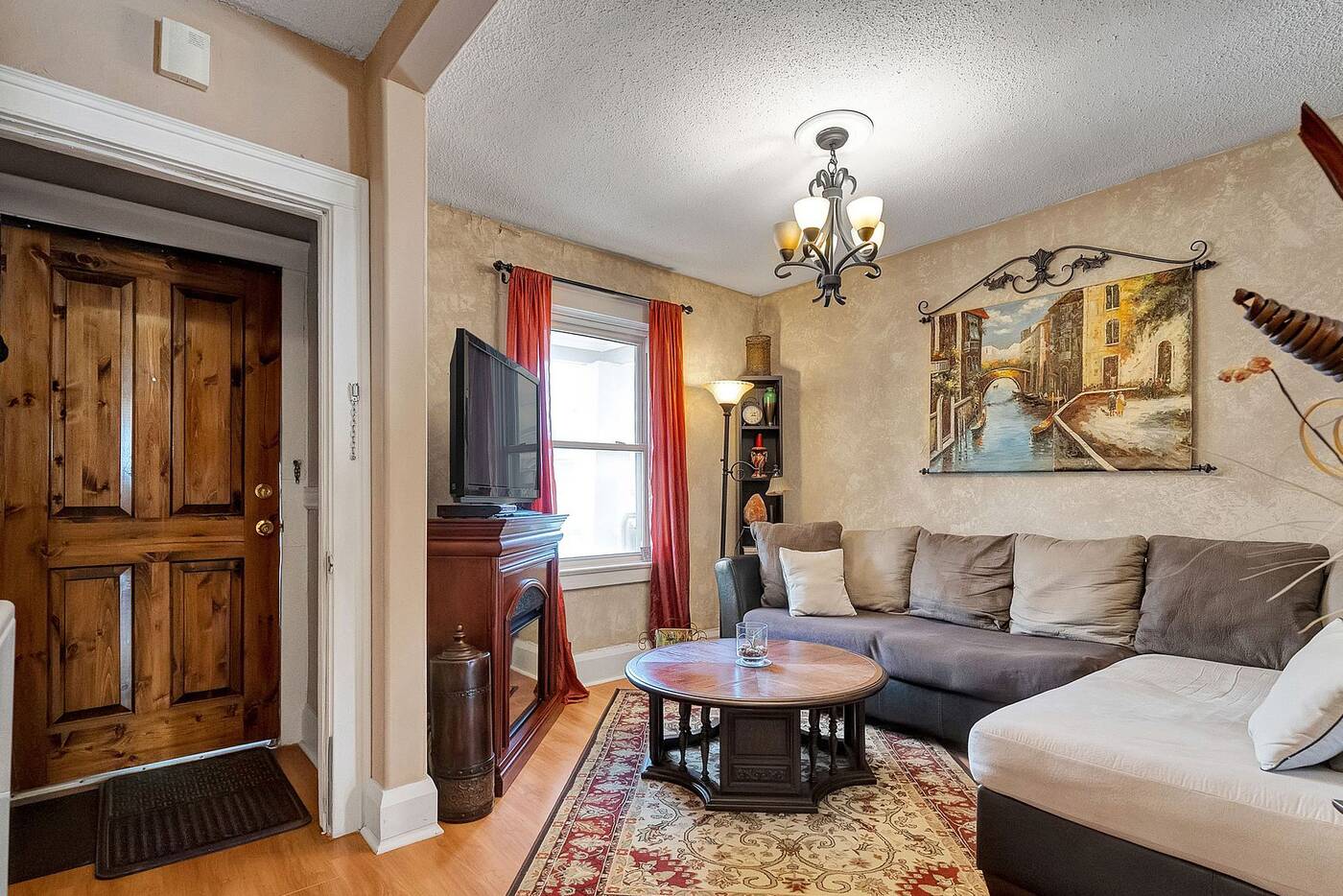

The entryway.
What’s weird is this house has changed ownership a few times since the 90s. In fact, it was most recently purchased in 2010 for $250,000.
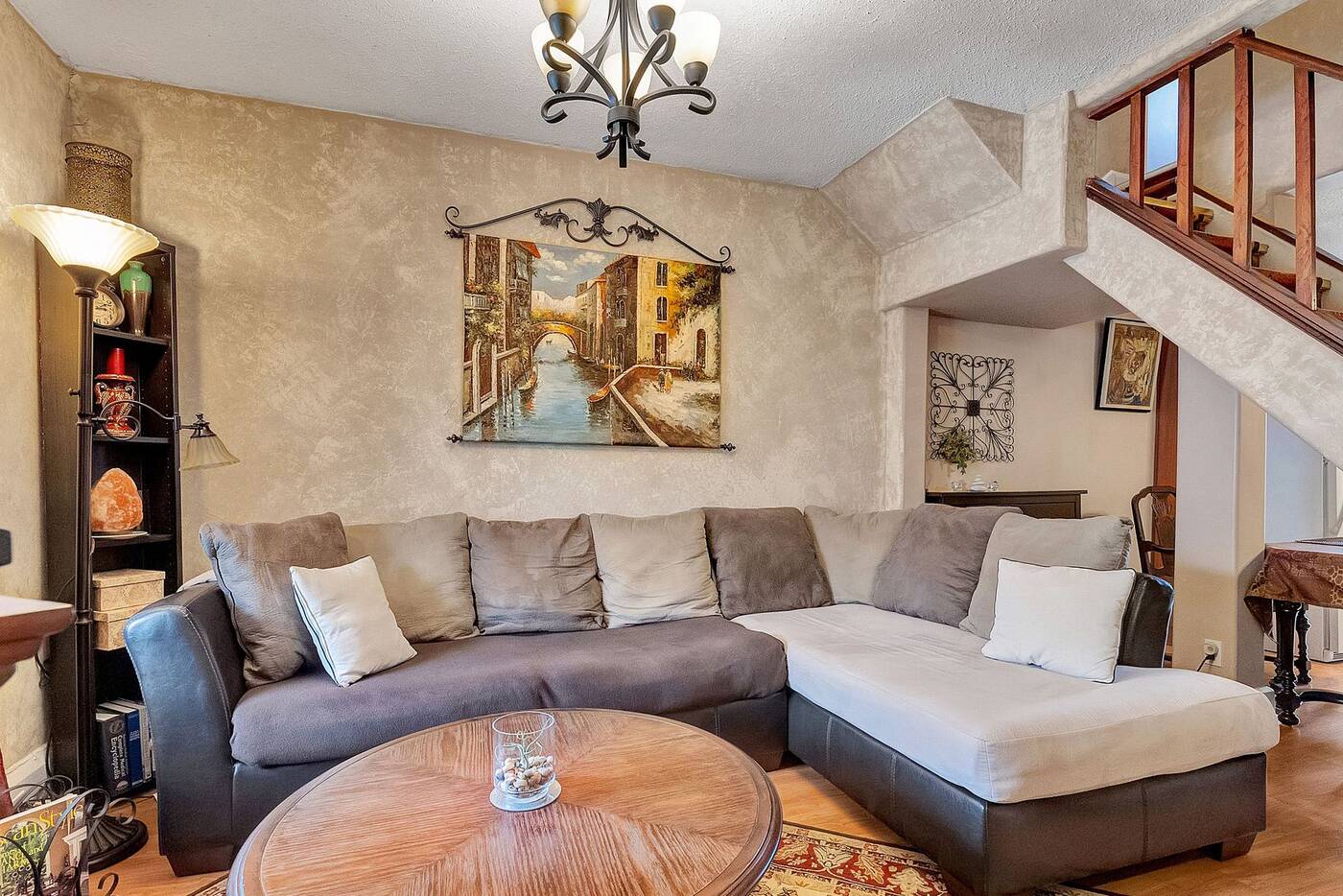

The living room.
So it’s somewhat surprising that when you look at past listing photos, almost nothing has changed. In fact, it seems they added the sponge-painted walls in 2010.
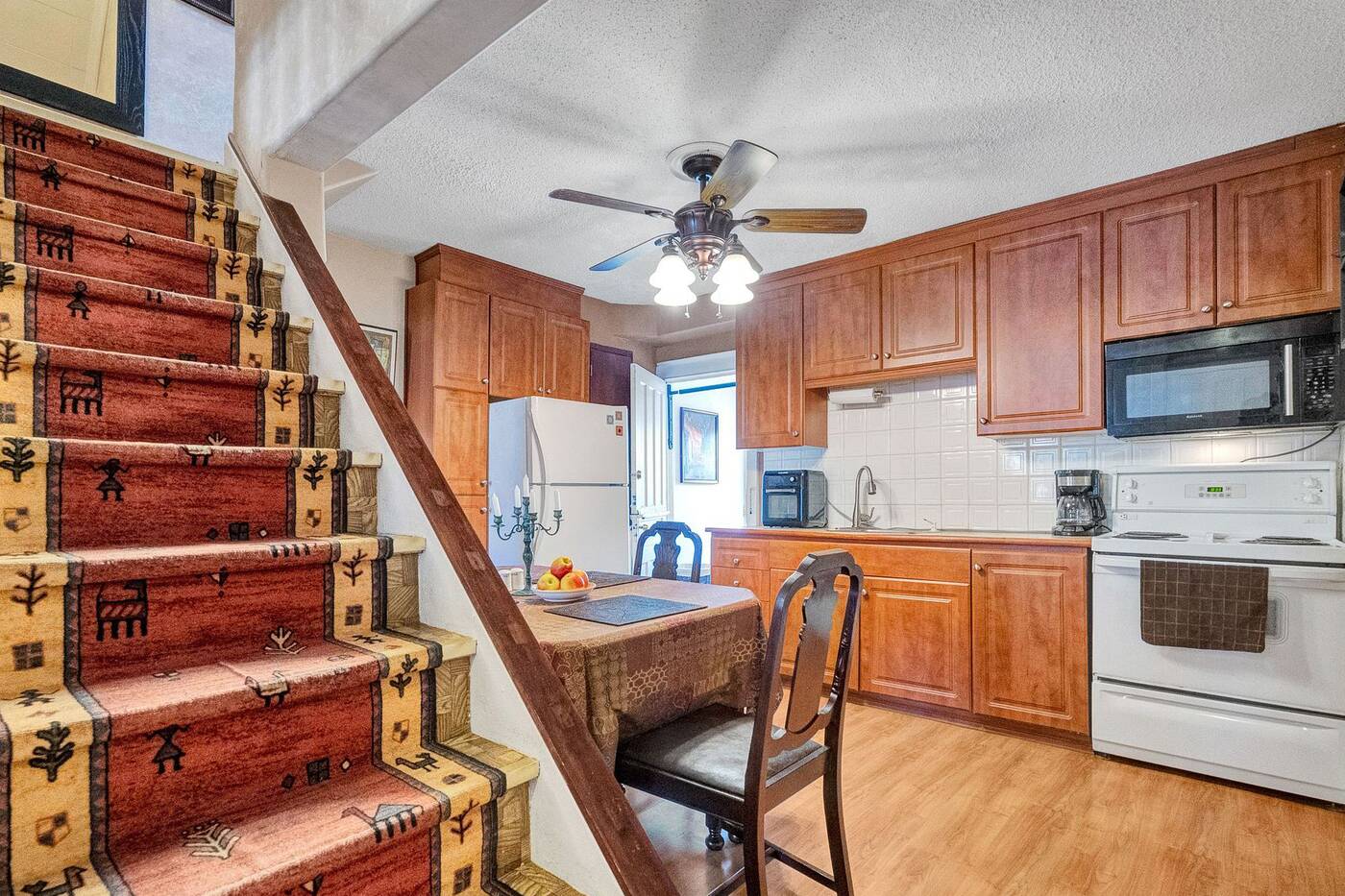

The kitchen.
But despite 39 Hartherley Rd. being a total throwback, this house is, as the listing says, “a diamond in the rough.”
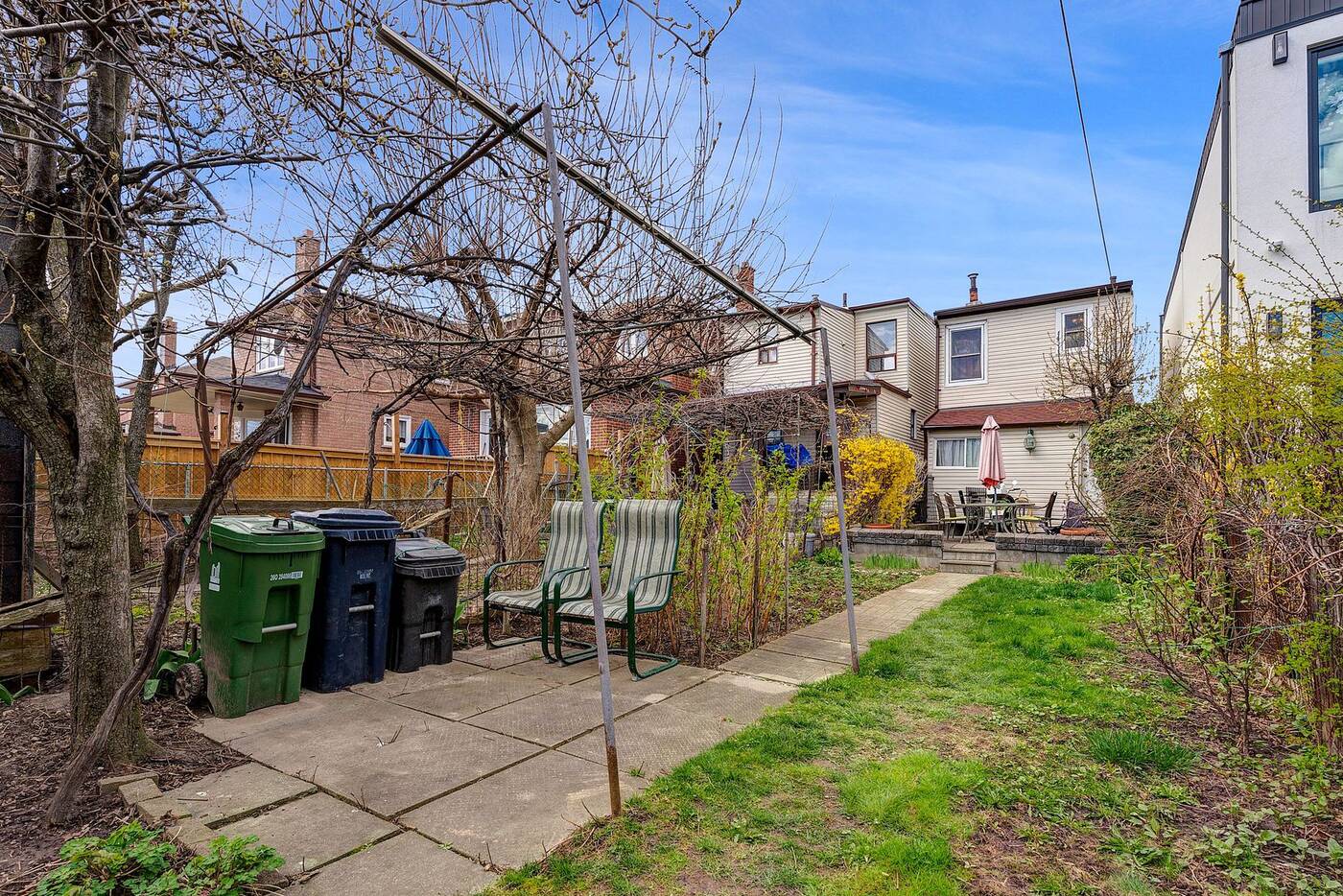

The backyard.
First off, it’s a detached house with a 125-foot deep lot in a good location.
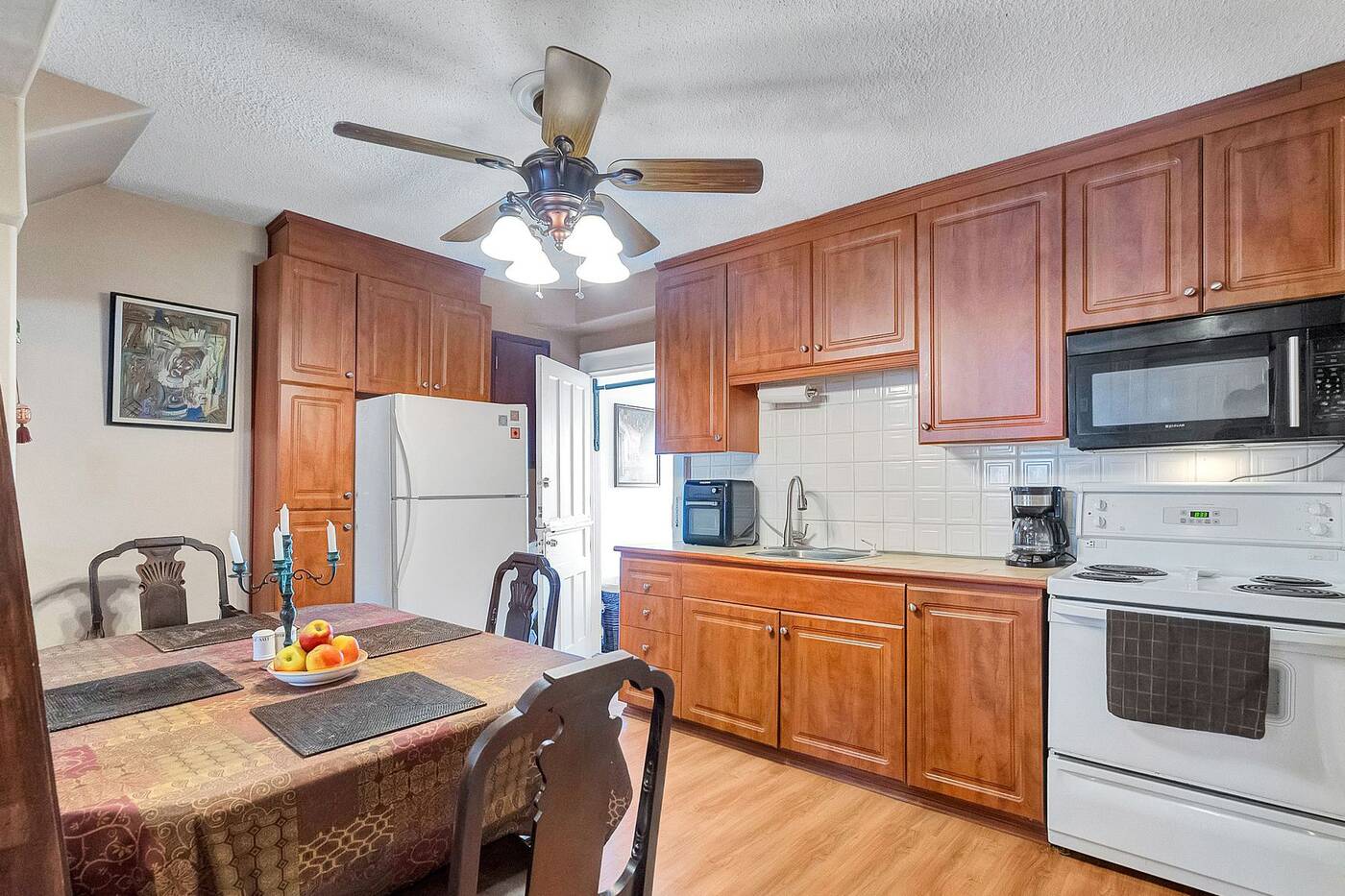

The kitchen has plenty of storage but, sadly, no dishwasher.
The main floor has a living room and kitchen with enough space for a dining table.
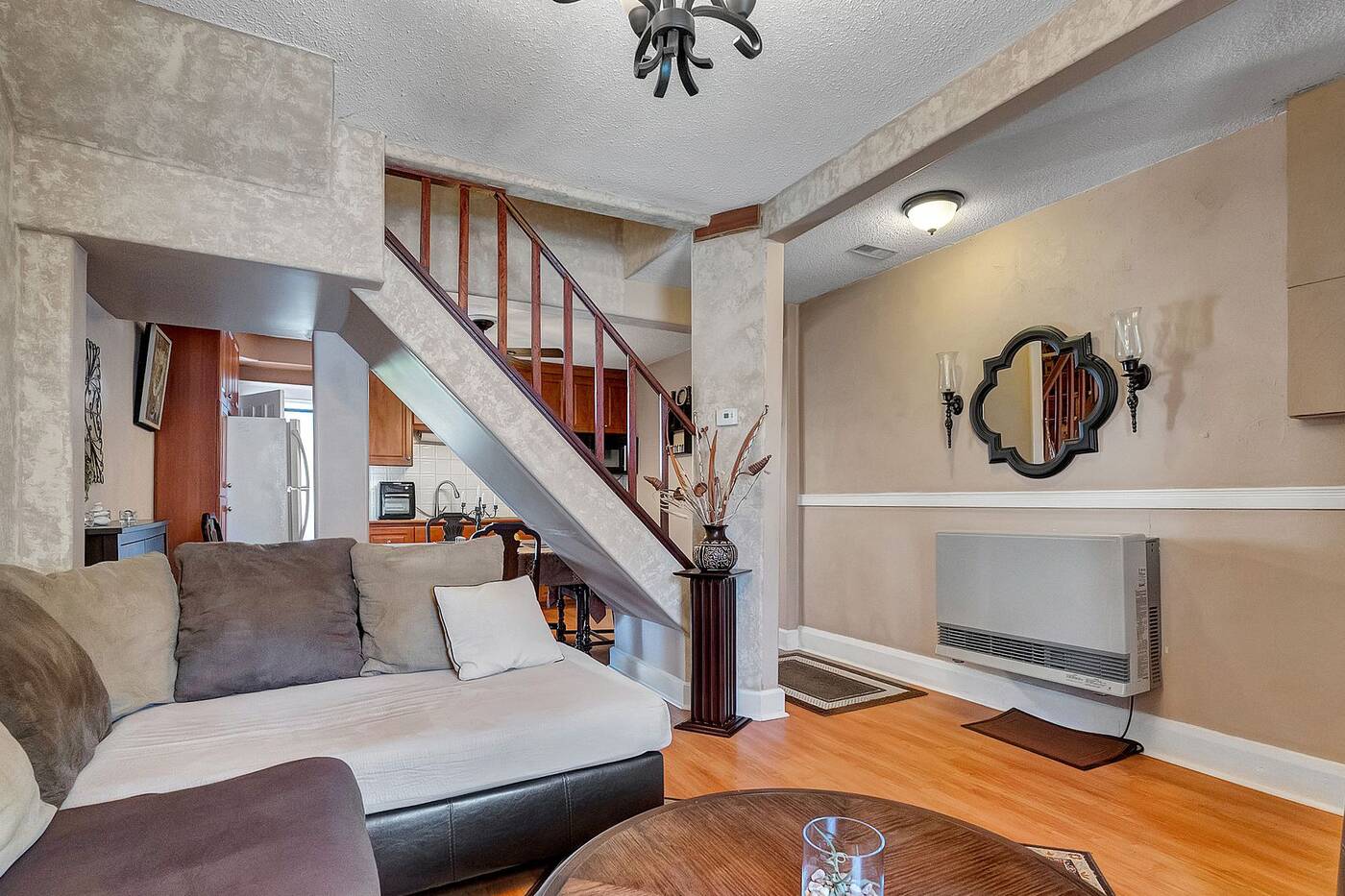

The main floor.
The layout is a bit awkward but the Dutch door off the kitchen is too cute.
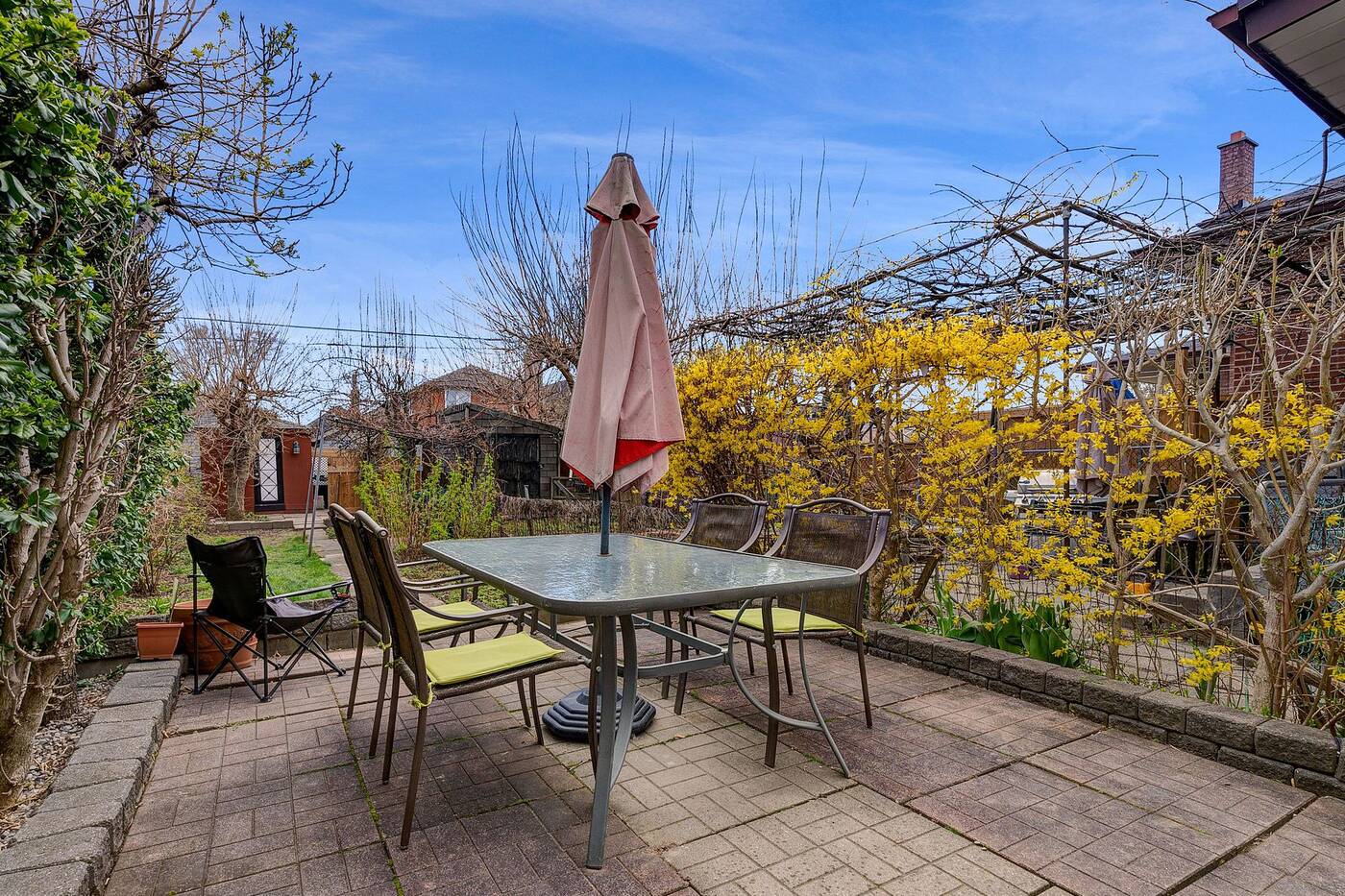

The back patio.
Off the kitchen is a laundry room/mud room that leads to the spacious backyard.
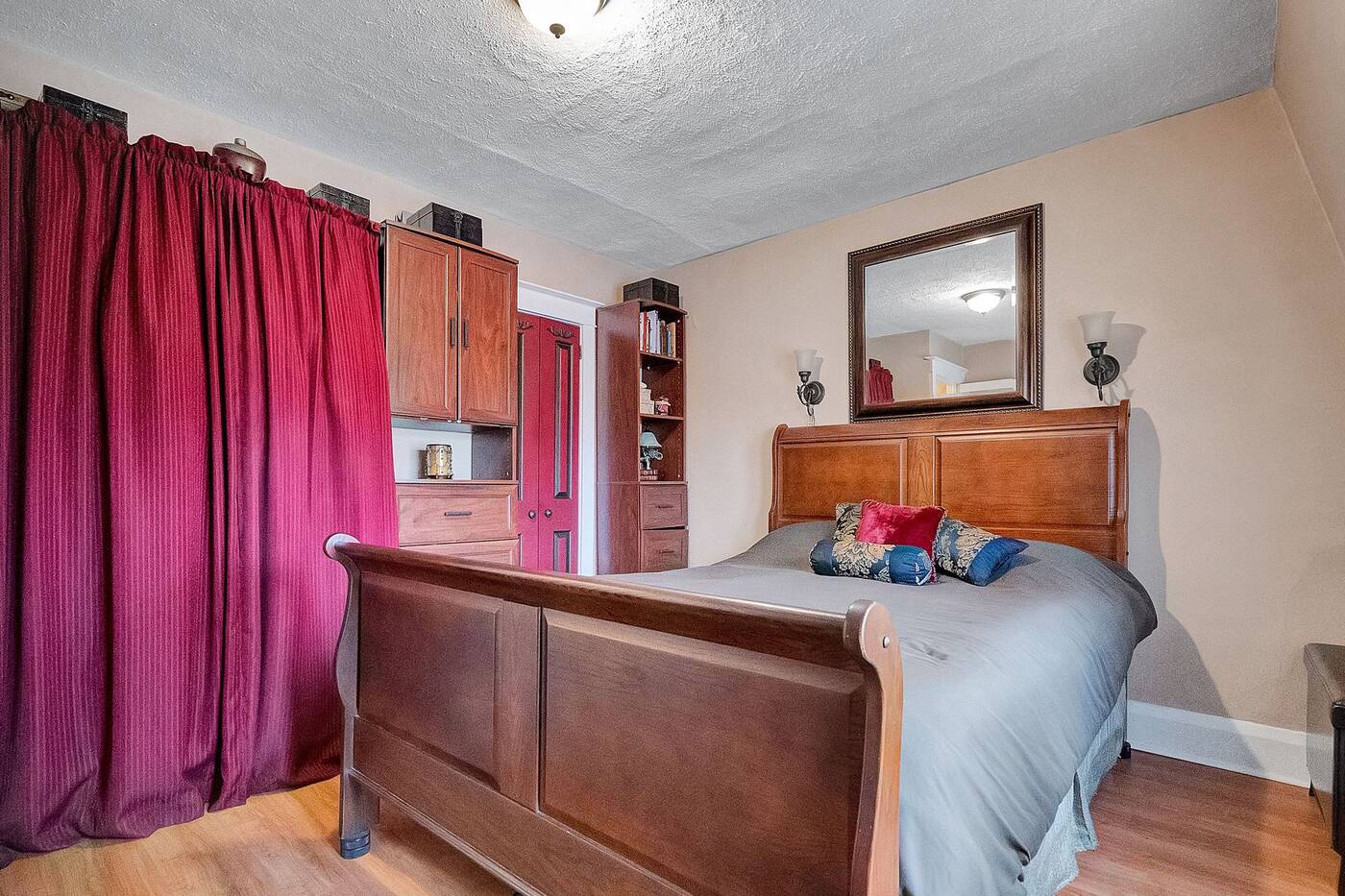

The primary bedroom.
Upstairs, there are two decently sized rooms and a small bathroom.
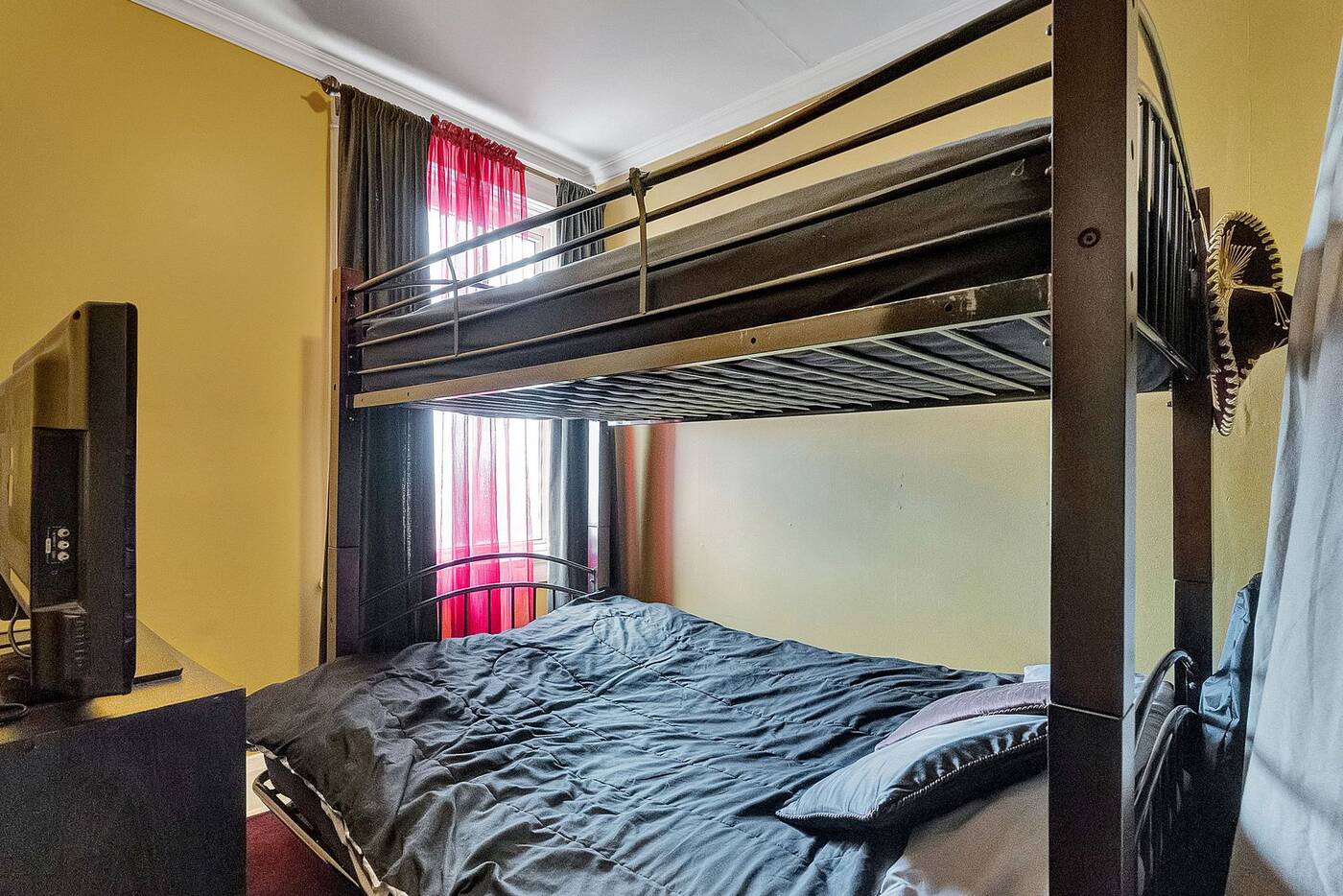

The second bedroom.
The house definitely needs some updating but the roof was done in 2015, the furnace is only a few years old, the electrical has been updated, and there’s room for expansion.
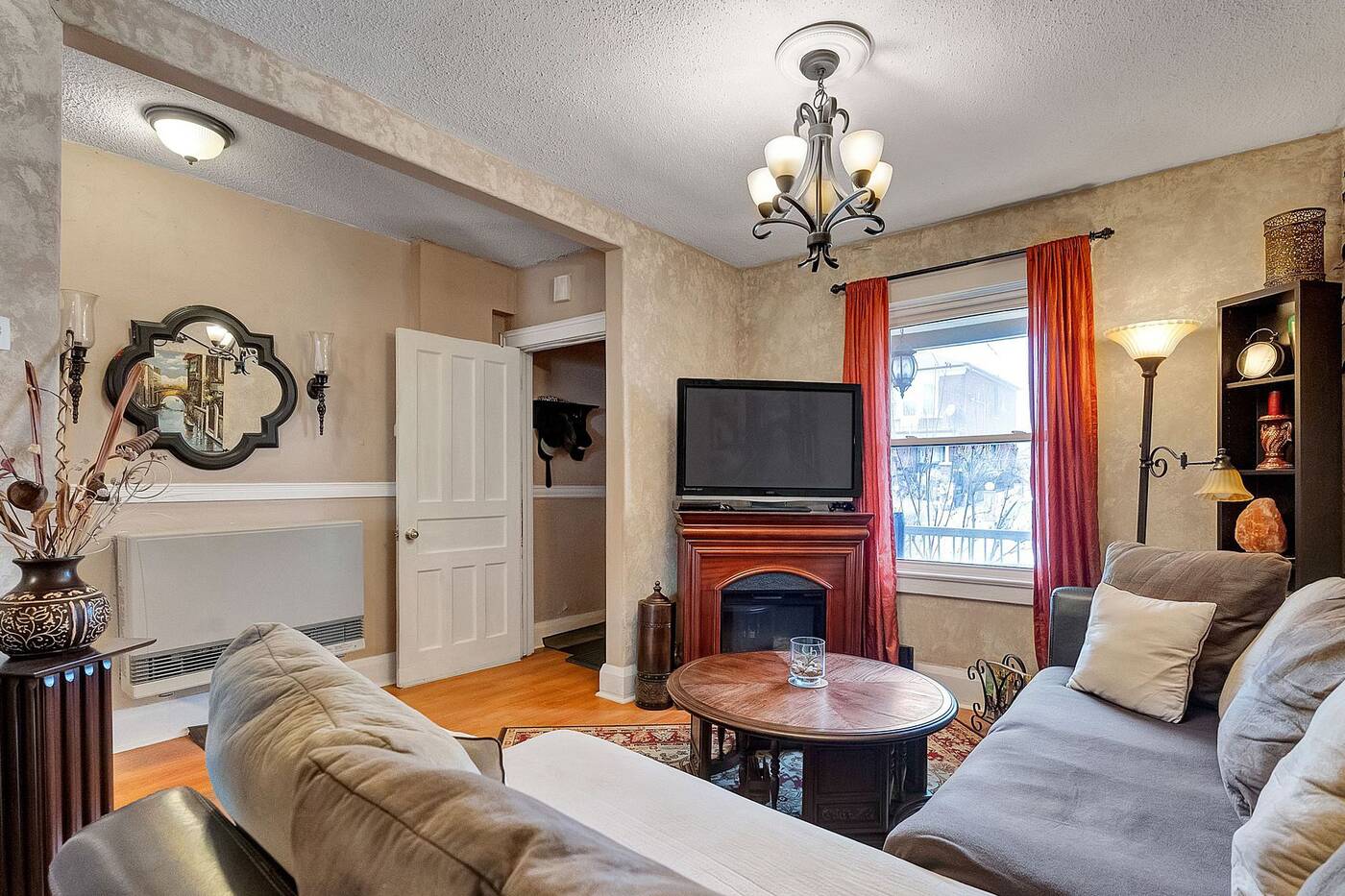

A fireplace in the living room.
Also, a coat of paint will do wonders to brighten up the all-beige ’90s aesthetic.
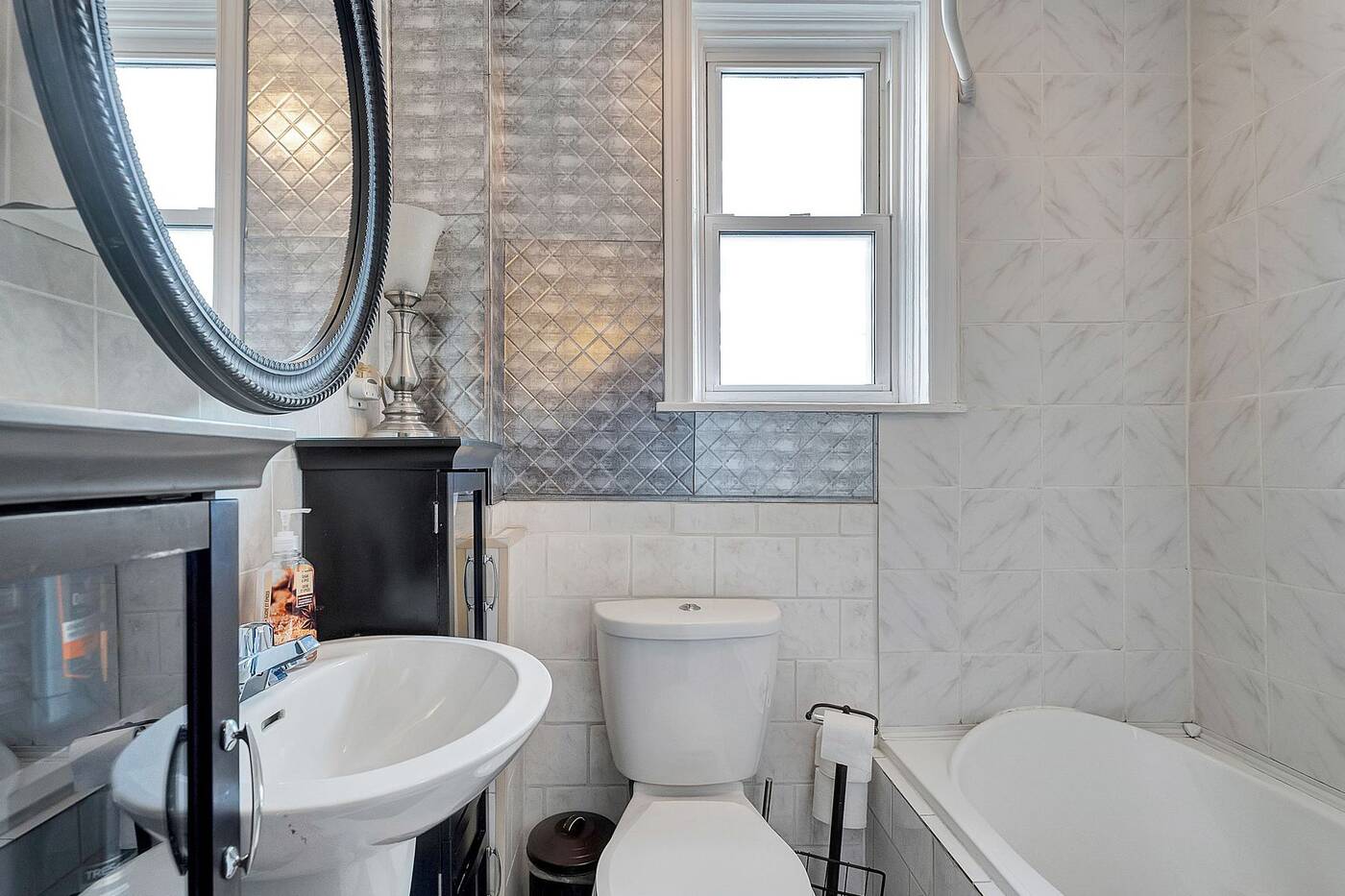

The small bathroom.
However, the biggest selling point of this home is the price point.
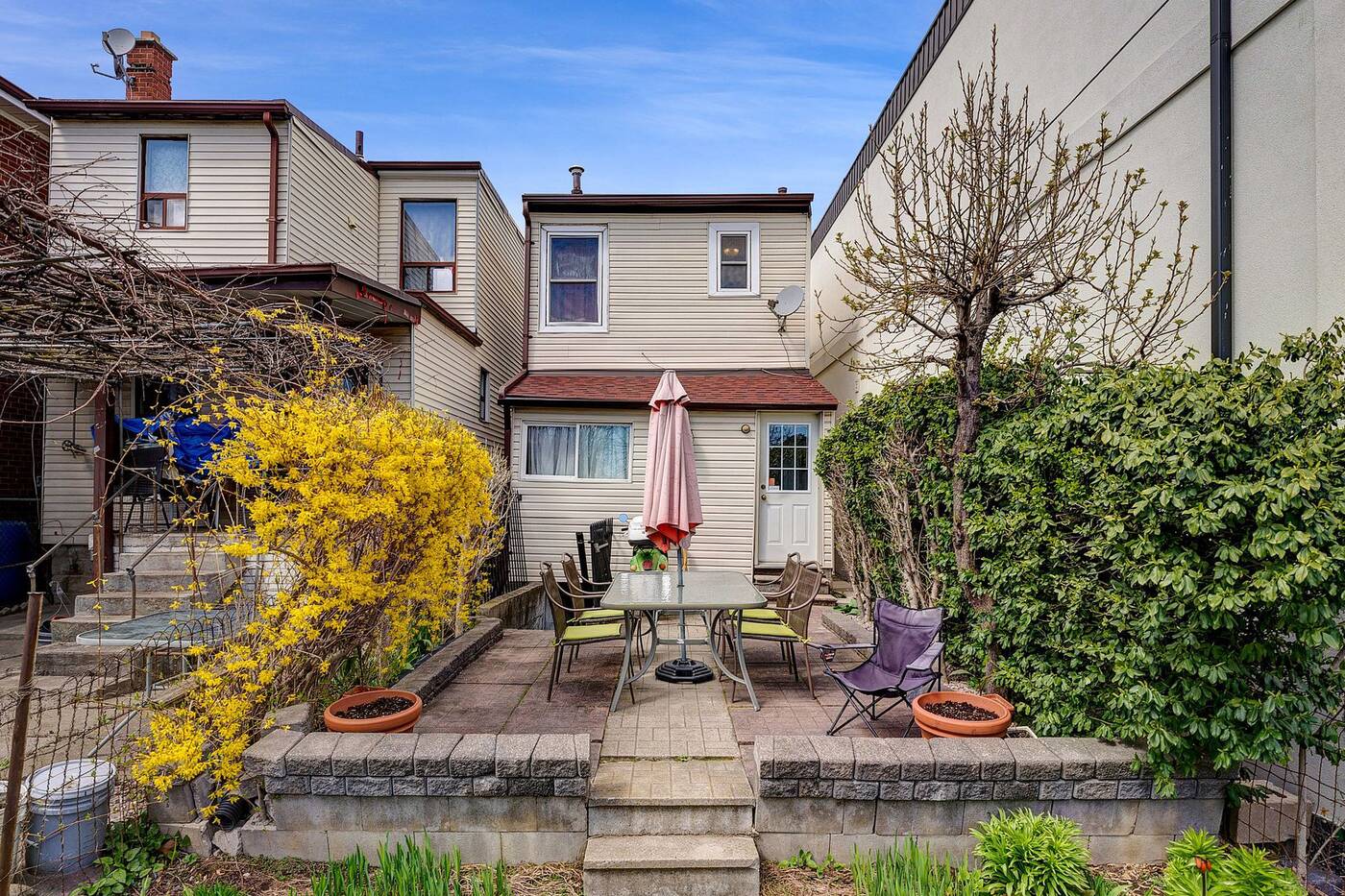

The back of the house.
39 Hatherley Rd. is listed for only $599,999, which is almost unheard of in Toronto, even if this place will probably go for closer to $700K.




Real eState
Blending Function and Style: The Best Garage Door Designs for Contemporary Homes


|
|
Modern and contemporary residences stand out with streamlined shapes and minimalist designs. They span from sleek global styles to cozy ranch layouts, offering something unique for all tastes.
Selecting the perfect garage door can pose a challenge for homeowners. Garage doors seamlessly blend with style and durability. This article offers insights on choosing garage doors that complement contemporary homes.
Key Architectural Elements
Contemporary homes are distinguished by their clean lines and minimalist aesthetics. Architects focus on crisp, sharp lines to delineate spaces distinctly. Expansive windows often play a pivotal role, inviting natural illumination indoors and blurring boundaries between interior and exterior living.
Materials utilized are typically modern, like glass, steel, and concrete, contributing to a cohesive design that emphasizes simplicity.
In these designs, every element serves a purpose. There’s no room for superfluous details. Hues tend to remain neutral or monochrome, creating a canvas where architectural forms take center stage.
This approach ensures that today, garage doors look like part of the house. They use the same materials and designs as the home’s outside.
Home Styles: From International to Ranch
Houses come in many different styles. The international style is from the 1910s and has European influences and industrial design. This style is simple and focuses on function.
On the other hand, classic American homes like Cape Cod, country French, Colonial, Tudor, and ranch all look different. Cape Cod homes are symmetrical and simple. Country French styles look rustic and elegant. Colonial houses are formal with balanced proportions. Tudor homes have steep roofs and decorative wood beams.
Ranch-style homes are one story and blend the indoors and outdoors. All these styles developed over time and show different cultural influences. Each style needs a specific type of garage door to match the overall look – like traditional panels for Colonial or Cape Cod homes, or sleek options for modern or contemporary homes.
The variety of home styles reflects how architecture has changed, not just in design but in the cultural influences behind each style.
Garage Door Styles for Contemporary Homes
Today’s modern homes demand garage doors blending sleek lines with practical use. From minimalist to sophisticated, various styles fit any contemporary aesthetic perfectly.
Traditional and Raised Panel Options
Traditional and Raised options meld classic appeal with modern flair, and According to the experts of garage door repair West Vancouver experts, they are ideal for today’s homes. These garage doors boast rectangular raised panels adding depth and texture to any facade. Each meticulously designed panel exudes elegance while respecting the home’s architectural integrity. Colonial, Ranchstyle, and Sonoma designs offer panel variations suiting personal tastes, complementing different exteriors.
Choosing the right traditional door involves subtle differences:
- Colonial panels evoke old-world charm.
- The ranch style is laid-back yet chic.
- Sonoma stands out in refined simplicity.
Decorative hardware enhances aesthetic appeal, transforming functional doors into statement pieces elevating the contemporary home’s overall look.
The Carriage House Appeal
Carriage house doors blend timeless style and modern function—a perfect pick for homes nodding to tradition. Owners love their timeless elegance elevating exterior design.
Carriage house doors stand out. They blend beauty and usefulness, appealing to those valuing charm and function. These garage doors combine tradition with modern homeowner needs. Available in various materials and colors, they customize to any home style – from international flair to ranch simplicity.
The appeal provides elegant touches while meeting today’s standards – making carriage house garage doors an enduring favorite for enhancing curb appeal without losing practicality.
Sleek Contemporary Designs
Sleek contemporary garage door designs offer minimalist, modern looks with clean geometric lines and patterns. Ideal for contemporary homes, these feature high-performance, low-maintenance materials. They boast subtle colors blending seamlessly with home exteriors. The key is using durable yet stylish natural looks.
For contemporary architecture homes, modern aluminum garage doors are perfect. Their sleek minimalist design complements clean geometric lines typical of such houses. Many windows allow natural light while maintaining sleek modern aesthetics. Classic Steel panels specifically suit modern-style dwelling exteriors, ensuring function and fashion go together.
Selecting the Right Garage Door
Picking a garage door combines appearance with utility, making your house exceptional. Judge both looks and toughness to get a flawless match for your contemporary abode.
Durable and Stylish Material Options
Steel garage doors strike a great balance of affordability, resilience, and chic style for contemporary residences. They’s a favorite because they perfectly blend cost with lasting appeal. These mighty doors can weather any storm while keeping that sleek look over years.
Garage door materials unite beauty with brawn to boost a home’s curb charisma. Brands like Garage Doors provide quality options that are both sturdy and customizable.
Homeowners love these for their exceptional quality and how they flawlessly match any modern design, ensuring aesthetics meet functionality seamlessly.
Colour Schemes Enhancing Exterior Design
Picking the right color scheme for a garage door can transform a contemporary home’s exterior design. Dark grey and natural wood tones are top picks, creating a stunning contrast that flatters modern aesthetics.
Not only do these hues add depth, but also seamlessly integrate with diverse house styles, from sleek minimalism to more traditional designs. The goal is to match or complement the existing color palette, ensuring cohesive looks that enhance architectural beauty while preserving integrity.
Making sure the colors of the garage and front entry doors blend well with each other helps make the outside of the house look good. This is a smart move that shows care was put into home renovations.
Balancing Design with Functional Requirements
After picking the right color scheme, striking a balance between design and practical needs is key. A garage door needs to look nice but also works well for daily use. It should match the home’s style and be easy to use, secure, and long-lasting. Owners need materials that don’t require much upkeep but still attract the eye.
Security can’t be forgotten either. Looking good is great, but a garage door must help keep the home safe too. Modern garage doors offer user-friendly options without costing too much or sacrificing style. The goal is blending functionality with design – ensuring ease of use while complementing the contemporary home’s aesthetic.
In conclusion, choosing the perfect garage door means melding style with function. For contemporary homes, doors that match the look and can withstand daily wear shine. Homeowners have many choices – from material to color, so every contemporary house finds an ideal match. Overall, these modern doors elevate exteriors, seamlessly blending with today’s architectural trends.
Real eState
Once the West Coast's crown jewel, San Francisco's real estate market is crashing – New York Post


San Francisco, once the crown jewel of the West Coast, is now teetering on the brink of collapse — and it seems like nobody is sounding the alarm.
The city’s housing market, in particular, has been hit hard over the past year, with prices plummeting and homeowners fleeing in droves.
JPMorgan Chase CEO Jamie Dimon didn’t mince words when he compared San Francisco’s woes to those of New York City, calling the Bay Area “in far worse shape.”
“I think every city, like every country, should be thinking about what makes an attractive city,” Dimon told Maria Bartiromo in an interview on Fox Business.
“It’s parks, it’s art, but it’s definitely safety, it’s jobs and job creation, it’s the ability to have affordable housing. Any city that doesn’t do a good job will lose its population.”
San Francisco is failing on all fronts and in turn, its housing market is quietly crashing.
Once-luxurious properties are now listing and selling for massive discounts just to attract buyers.
Consider the penthouse at the San Francisco Four Seasons Residential, initially listed in November 2020 for $9.9 million, now begging for buyers at $3.75 million — a jaw-dropping 62% markdown.
It remains on the market today.
Homeowners desperate to escape the sinking ship are offloading their properties at losses, with many seeing their investments dwindle by hundreds of thousands of dollars in just months.
A five-bedroom home at 478-480 Fourth Ave. sold for $1.1 million earlier this month, after selling less than a year prior for $1.6 million.
At 88 King St., a two-bedroom condo overlooking a ball park that sold for $1.12 million more than a decade ago in 2014, recently sold last month for $1.08 million.
Another two-bedroom condo at 1075 Market St., which sold in 2019 for $1.25 million just traded hands earlier this month for $675,000 — and after a price cut, to boot.
The broader trend, according to the latest Redfin analysis, is stark. Nearly one in five homeowners in San Francisco are selling their homes for a loss.
Another one among them: A rare home overlooking the Golden Gate Bridge with oceanfront views was initially listed for the first time in nearly 35 years last March for a price of $12.8 million.
After several price cuts, it took a year to sell at the fairly modest price tag $7.85 million for the area.
The commercial sector isn’t faring any better, with office vacancies soaring post-pandemic.
And the desperation is palpable, as evidenced by the recent sale of a property on Market Street at a mind-boggling 90% discount.
The building at 995 Market St. was acquired for just $6.5 million during a public auction last week.
The previous owner had paid $62 million for it in 2018.
Even retail giants are abandoning ship.
In February, Macy’s announced that it was closing its massive flagship store in San Francisco’s Union Square.
The year prior, Nordstrom had announced it was closing two of its stores over the “deteriorating situation in the area.”
The mall had been inundated with fentanyl overdoses, drug dealers and thieves.
Real estate veteran Craig Ackerman, who’s witnessed San Francisco’s rise and fall over three decades, laments the city’s potential squandered by inept leadership.
He predicts years of continued mismanagement unless drastic changes are made. However, with the current administration’s penchant for liberal grandstanding over pragmatic solutions, the outlook remains grim.
“I do think that San Francisco probably has another five to eight years of mismanagement. I mean things are a mess out here and they don’t need to be. This could all be changed by the stroke of a pen,” Ackerman told The Post.
“But the mayor — they choose to continue this ridiculousness.”
“I don’t think it’s going to change,” Ackerman added.
“They are happy waving their liberal flags and looking for a fantasy land that doesn’t exist … It’ll kill you on the way there.”
-



 Health4 hours ago
Health4 hours agoRemnants of bird flu virus found in pasteurized milk, FDA says
-
Art10 hours ago
Mayor's youth advisory council seeks submissions for art gala – SooToday
-



 Science18 hours ago
Science18 hours ago"Hi, It's Me": NASA's Voyager 1 Phones Home From 15 Billion Miles Away – NDTV
-
Media15 hours ago
Jon Stewart Slams the Media for Coverage of Trump Trial – The New York Times
-
News16 hours ago
Some Canadians will be digging out of 25+ cm of snow by Friday – The Weather Network
-
Art22 hours ago
Made Right Here: Woodworking art – CTV News Kitchener
-



 Investment9 hours ago
Investment9 hours agoTaxes should not wag the tail of the investment dog, but that’s what Trudeau wants
-



 Sports19 hours ago
Sports19 hours agoAuston Matthews turns it up with three-point night as Maple Leafs slay Bruins in Game 2 – Toronto Sun




